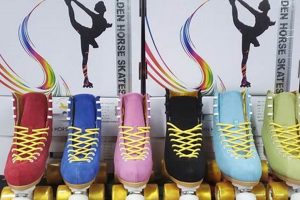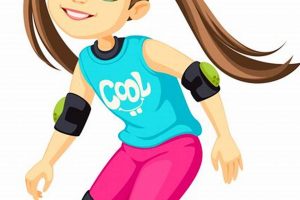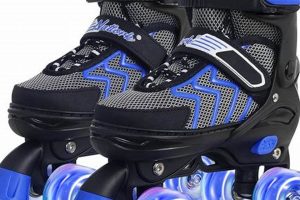Individuals with broader foot dimensions require specialized footwear to ensure comfort and proper fit. Standard roller skate designs often cater to average foot widths, potentially causing discomfort, pain, or restricted movement for those with wider feet. This necessitates the availability of models specifically engineered to accommodate a broader foot profile, providing ample space in the toe box and midfoot area. An example is a skate boot constructed with a wider last, offering greater internal volume compared to a standard fit.
Properly fitted skates are essential for optimal performance and injury prevention. Ill-fitting skates can lead to blisters, bunions, and reduced control, hindering the skating experience. The availability of appropriately sized skates contributes significantly to user enjoyment, skill development, and long-term participation in skating activities. Historically, limited options existed, forcing many to endure discomfort. However, advancements in design and manufacturing have expanded the selection of skates catering to diverse foot shapes and sizes.
The subsequent sections will delve into various aspects relevant to selecting suitable skates for broader feet, including key features to consider, different types of skates available, and practical tips for ensuring a comfortable and secure fit. This encompasses an examination of adjustable features, materials, and brands known for their wider-fit offerings.
Essential Considerations for Roller Skate Selection
This section outlines crucial factors to consider when selecting roller skates that accommodate wider feet, ensuring a comfortable and effective skating experience.
Tip 1: Boot Width Evaluation: Assess the internal width of the skate boot. Specific models are designed with a wider last to provide additional volume. Consult sizing charts provided by manufacturers, paying close attention to width measurements.
Tip 2: Adjustable Features: Seek skates with adjustable features, such as laces, buckles, or Velcro straps. These allow for customized tightening and loosening to accommodate varying foot dimensions and prevent constriction.
Tip 3: Liner Material: Opt for skates with heat-moldable liners or those made from pliable materials. These materials can conform to the foot’s shape over time, creating a more personalized and comfortable fit.
Tip 4: Toe Box Design: Examine the toe box to ensure ample space for the toes to move freely. A wide toe box minimizes pressure and prevents discomfort, particularly during extended skating sessions.
Tip 5: Professional Fitting: Consider visiting a reputable skate shop for a professional fitting. Experienced staff can assess foot measurements and recommend suitable models based on individual needs.
Tip 6: Brand Research: Investigate brands known for producing skates with wider fits. Some manufacturers specialize in catering to individuals with broader foot profiles.
Tip 7: Online Reviews: Consult online reviews and forums to gather insights from other users with wide feet regarding their experiences with specific skate models.
Adherence to these guidelines will facilitate the selection of skates that provide a secure, comfortable, and performance-enhancing fit.
The following section will explore specific skate types and models that frequently accommodate wider feet, providing further guidance in the selection process.
1. Boot Width
Boot width is a fundamental characteristic directly impacting the suitability of roller skates for individuals with wider feet. Insufficient boot width leads to constriction, discomfort, and impaired circulation, ultimately diminishing performance and increasing the risk of foot-related injuries. The availability of skates specifically designed with increased boot width addresses this critical need, accommodating the broader foot structure and allowing for a more natural and comfortable skating experience. For example, a skate marketed with a “wide fit” designation typically features a broader last and increased internal volume compared to standard models.
The consequences of neglecting boot width consideration are varied and can significantly affect the user. Tight-fitting skates can induce blisters, calluses, and bunions, particularly during prolonged use. Furthermore, restricted toe movement compromises balance and control, potentially leading to falls. By contrast, a properly sized boot width facilitates unrestricted foot movement, promoting stability and enhancing maneuverability. Specific brands now offer customizable options, allowing users to select from various width profiles to achieve a truly personalized fit. This level of customization demonstrates the increasing recognition of boot width as a critical factor in skate design.
In summary, boot width represents a central element in the effective design and selection of roller skates intended for wider feet. Prioritizing adequate boot width is essential for optimizing comfort, enhancing performance, and mitigating the risk of foot-related complications. Failure to adequately address boot width limitations compromises user experience and underscores the importance of seeking out models specifically engineered to accommodate wider foot dimensions. This ultimately contributes to a safer and more enjoyable skating experience for all.
2. Adjustability
Adjustability is a crucial element in roller skate design, particularly for individuals with wider feet. The inherent variability in foot dimensions necessitates mechanisms to fine-tune the fit, mitigating potential discomfort or performance limitations. Laces, buckles, and hook-and-loop straps are common adjustable components. Insufficient adjustability forces users to compromise between excessively tight skates, which restrict circulation and cause pain, or skates that are too loose, leading to instability and reduced control. A skate featuring multiple points of adjustment, for instance, allows for independent tightening around the instep and ankle, accommodating variations in foot volume that are characteristic of wider feet.
The practical significance of adjustability extends beyond mere comfort. A secure and properly adjusted fit enhances energy transfer during skating, improving efficiency and reducing fatigue. For example, skaters performing complex maneuvers require a snug fit that minimizes foot slippage within the boot. Conversely, a relaxed fit may be preferred for recreational skating, prioritizing comfort over peak performance. Adjustable systems enable users to adapt the fit based on activity and personal preference. Several manufacturers now offer micro-adjustable buckles that permit incremental adjustments, further refining the fit.
In conclusion, adjustability represents a critical design consideration in roller skates for wide feet. It bridges the gap between standardized skate sizes and the diversity of individual foot shapes, promoting comfort, performance, and safety. While properly sized boots are fundamental, adjustability systems provide the necessary fine-tuning to optimize fit and accommodate the specific needs of skaters with wider foot profiles. Challenges remain in creating highly adaptable systems that are both durable and easy to use, but ongoing innovation in this area is essential for improving the overall skating experience.
3. Liner Material
Liner material in roller skates directly impacts comfort and fit, especially for individuals with wider feet. The material’s properties determine its ability to conform to the foot’s shape, offering relief from pressure points and reducing the likelihood of friction-induced blisters. A stiff, unyielding liner in a skate intended for wider feet can negate the benefits of a wider boot design, as the lack of malleability will continue to constrict the foot. Conversely, liners constructed from heat-moldable foams or pliable textiles can better adapt to the contours of a wider foot, distributing pressure more evenly. For instance, skates with memory foam liners often provide a more customized fit over time, conforming to the specific shape of the user’s foot, mitigating discomfort associated with ill-fitting liners.
Beyond comfort, the type of liner material influences the overall performance and longevity of the skate. Higher-quality liners, typically found in more expensive models, offer enhanced cushioning and support, contributing to improved control and reduced fatigue during extended skating sessions. Materials like closed-cell foam provide better insulation and moisture management, preventing sweat buildup that can lead to discomfort and odor. Furthermore, durable liner materials withstand repeated use and compression, maintaining their shape and support over time. A skate with a cheap, easily compressed liner might initially feel comfortable but quickly lose its supportive properties, leading to foot fatigue and a compromised skating experience. Therefore, the selection of liner material is an important factor in determining the long-term suitability of roller skates, particularly for those requiring accommodations for wider feet.
In summary, the choice of liner material represents a critical consideration when selecting roller skates designed for wider feet. The liner’s ability to conform to the foot’s shape, provide cushioning, and manage moisture significantly impacts comfort, performance, and the overall lifespan of the skate. Skaters with wider feet should prioritize skates featuring liners made from pliable, heat-moldable, or memory foam materials to maximize comfort and ensure a secure, supportive fit. The integration of advanced materials in skate liners represents an ongoing area of development, aiming to further enhance the skating experience for individuals with diverse foot shapes and sizes.
4. Toe Box Space
Toe box space, within the context of roller skates designed for wide feet, represents a critical dimension directly impacting comfort, foot health, and skating performance. Adequate toe box volume prevents constriction, promotes natural foot splay, and minimizes the risk of various foot ailments. The following points elaborate on specific facets of toe box space relevant to individuals with broader foot profiles.
- Width and Height Dimensions
The toe box must accommodate both the width and height of the toes. Insufficient width compresses the toes laterally, leading to discomfort and potential bunion development. Inadequate height forces the toes into a flexed position, contributing to hammertoe formation. Roller skates designed for wide feet should feature a toe box with generous width and height, allowing the toes to lie flat and move freely.
- Impact on Circulation and Nerve Function
A constricted toe box impedes blood circulation and compresses nerves in the feet. This can result in numbness, tingling, and pain, particularly during extended skating sessions. Ample toe box space ensures proper blood flow and nerve function, reducing the risk of these complications. Skates that are appropriately designed consider these physiological factors.
- Influence on Balance and Stability
The toes play a crucial role in maintaining balance and stability during skating. When the toes are compressed, their ability to grip and stabilize is diminished, increasing the risk of falls. A wider toe box enables the toes to function effectively, enhancing balance and promoting confident skating. The design of the toe box significantly impacts the skater’s stability.
- Material Properties and Construction
The material and construction of the toe box influence its ability to accommodate wider feet. Stiff, inflexible materials offer limited give, further exacerbating constriction. Conversely, pliable materials or designs incorporating stretch panels provide greater adaptability and comfort. The construction should also avoid seams or overlays that could cause friction or pressure points within the toe box.
These considerations highlight the importance of adequate toe box space in roller skates designed for wide feet. A well-designed toe box not only enhances comfort but also promotes foot health, optimizes performance, and reduces the risk of injuries. Therefore, individuals with wider feet should prioritize skates that feature a spacious and accommodating toe box to ensure a safe and enjoyable skating experience.
5. Professional Fitting
The connection between professional fitting and roller skates tailored for wide feet is paramount, representing a critical step toward ensuring comfort, performance, and injury prevention. Standard sizing conventions often fail to adequately address the nuanced dimensions of wider feet, leading to suboptimal skate selection. Professional fitting, conducted by experienced personnel, mitigates this issue through precise foot measurement and assessment, enabling informed recommendations aligned with individual needs. For example, an individual with a wide forefoot may require a skate model with a wider last or a boot that can be heat-molded to conform to their unique foot shape. Without professional guidance, this individual may inadvertently select a standard-width skate, resulting in discomfort, blistering, or compromised performance.
Professional fitting extends beyond simple size determination. It encompasses an evaluation of arch height, foot volume, and pronation tendencies, all of which influence skate selection. A fitter can identify pressure points and recommend adjustments, such as custom insole placement or modifications to the skate’s lacing system, to alleviate discomfort and optimize fit. Moreover, professional fitters possess expertise regarding different skate brands and models, allowing them to guide customers toward options specifically designed to accommodate wider feet. The practical significance of this understanding lies in the prevention of common skating-related injuries, such as plantar fasciitis or ankle instability, which are often exacerbated by ill-fitting skates. A properly fitted skate provides enhanced support, stability, and power transfer, ultimately improving the skater’s overall experience.
In conclusion, professional fitting represents an indispensable component of acquiring roller skates for wide feet. It addresses the limitations of standard sizing conventions, providing personalized guidance that optimizes comfort, performance, and injury prevention. While online resources and user reviews can offer valuable information, they cannot replace the expertise and individualized attention provided by a skilled professional fitter. Investing in professional fitting ensures that the selected skates accurately accommodate the unique dimensions of wider feet, resulting in a safer, more enjoyable, and more efficient skating experience. The challenge remains in increasing access to qualified fitters and ensuring that individuals with wide feet are aware of the significant benefits of professional assessment.
Frequently Asked Questions
The following questions address common inquiries regarding the selection and use of roller skates designed for individuals with wider feet. The answers aim to provide clear, concise, and factual information to facilitate informed decisions.
Question 1: What defines a “wide foot” in the context of roller skate sizing?
A “wide foot” typically refers to a foot measurement exceeding the average width for a given length, as determined by standard sizing charts. The specific measurement varies between manufacturers, but generally, individuals with a width grade of “E” or higher may benefit from skates designed for wider feet. Precise foot measurements using a Brannock device or similar tool are recommended for accurate assessment.
Question 2: How does the construction of roller skate boots specifically accommodate wider feet?
Roller skate boots designed for wider feet often incorporate a wider last, which refers to the foot-shaped form around which the boot is constructed. This wider last provides additional volume in the toe box and midfoot area. Materials may also be more pliable to reduce pressure points. Adjustability features, such as wider straps or lacing systems, are commonly included to allow for a customized fit.
Question 3: Can standard roller skates be modified to better fit wider feet?
While limited modifications are possible, significant alterations to standard roller skates are not generally recommended. Stretching or widening the boot material may compromise its structural integrity and support. However, replacing the insole with a thinner or custom-molded option can sometimes create additional space. Consulting a professional skate fitter is advised before attempting any modifications.
Question 4: Are specific types of roller skates (e.g., inline, quad) inherently better suited for wider feet?
No particular type of roller skate is inherently superior for accommodating wider feet. The suitability depends more on the specific brand, model, and design features. Both inline and quad skates can be found with wider fit options. Individual preference and skating style often dictate the choice between the two types.
Question 5: What are the potential consequences of using roller skates that are too narrow for the feet?
Using roller skates that are too narrow can lead to several adverse effects, including blisters, bunions, calluses, pinched nerves, and reduced circulation. Prolonged use of ill-fitting skates may also contribute to more serious foot problems, such as hammertoes or Morton’s neuroma. Compromised balance and reduced skating performance are also potential consequences.
Question 6: Where can roller skates specifically designed for wide feet be purchased?
Roller skates designed for wide feet can be found at specialized skate shops, online retailers that carry a diverse selection of skate brands, and some sporting goods stores. Consulting online reviews and brand websites can help identify retailers and models that cater to individuals with wider feet. A professional fitting at a reputable skate shop is highly recommended prior to purchase.
These responses provide a foundation for understanding the importance of proper fit when selecting roller skates, particularly for individuals with wider feet. Prioritizing comfort and fit is crucial for a safe and enjoyable skating experience.
The following section will summarize key takeaways and provide final recommendations for selecting roller skates suitable for wider feet.
Roller Skates for Wide Feet
This exposition has addressed the salient factors concerning roller skates for wide feet, underscoring the importance of proper fit for comfort, performance, and the prevention of foot-related injuries. Key aspects, including boot width, adjustability, liner material, and toe box space, have been delineated as crucial determinants in selecting appropriate footwear. The necessity of professional fitting, conducted by qualified personnel, has been emphasized as a means to mitigate the limitations of standardized sizing and ensure individualized assessment.
The acquisition of suitable roller skates for wide feet demands meticulous attention to detail and a commitment to prioritizing foot health and well-being. While a diverse range of models designed to accommodate broader foot profiles are increasingly available, informed selection remains paramount. Individuals are encouraged to utilize the knowledge presented herein to make judicious choices, fostering a safe and enjoyable skating experience. Failure to address these considerations may result in discomfort, injury, and compromised performance. Future developments in skate design should focus on enhancing adjustability, customization options, and the integration of advanced materials to further improve the fit and comfort of skates for all foot shapes and sizes.







![Boost Speed: Big Wheel Roller Skates - [Year] Guide Learn to Surf & Skate: A Beginner's Step-by-Step Guide Boost Speed: Big Wheel Roller Skates - [Year] Guide | Learn to Surf & Skate: A Beginner's Step-by-Step Guide](https://universitysurfandskate.com/wp-content/uploads/2025/12/th-719-300x200.jpg)